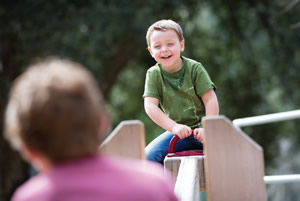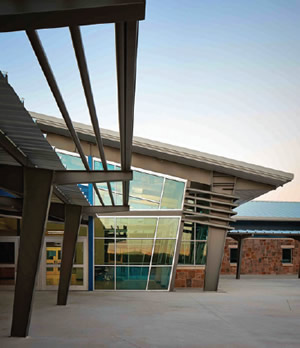Safety & Security (Prepare and Be Aware)
Tight As a Drum
Schools can easily evoke warm, welcoming environments when security is balanced with positive human interaction.

PHOTO © SHUTTERSTOCK/DAYNA MORE
Like many things in life, school security is about balance. On the one hand, administrators want safe schools, and to do that often means employing highly visible security measures, such as cameras, secure entry vestibules and metal detectors. On the other hand, administrators want school environments that are warm and welcoming to students, parents and other visitors. The conundrum is how to achieve this balance.
Administrators at Kettering City Schools (KCS) in Ohio are working toward that balance. In the wake of the Sandy Hook tragedy, the district, which serves 7,300 students in grades pre-K to 12, implemented new security measures in its 12 schools. “We have built secure vestibules at the main entrances to our buildings,” says Ken Lackey, director of Business Services. “Only the main door is unlocked during the school day. Visitors must enter through the main entrance, be identified and buzzed into the main office where they sign in and then have access to the rest of the building, if appropriate.” Surveillance cameras and alarms were placed in the vestibules, offices and other select locations, with monitors placed in the vestibules and main offices. In addition, barriers and public address systems were installed, and electronic access capabilities were added to select doors in every school. All staff now wear ID cards that allow them access to these doors.
In terms of nonphysical security measures, the district is also implementing ALICE (Alert, Lockdown, Inform, Counter, Evacuate) training. Combined, the new safety and security measures cost about $1 million, and is partly paid by an operating levy successfully passed in November 2013.
Looking to the future, says Lackey, who is also chair of the Safety and Security Committee, district officials are hoping to upgrade the walkie talkie program to one that includes direct communication with the local police department. They’re also investigating implementing panic alarms in each school office that are connected directly to the local police department.
“These measures won’t put us at 100 percent initially,” Lackey notes. “We have to watch and see how they work and make adjustments as we move forward.” Still he feels that the district has come a long way in making its schools safer: “Not only do I believe our schools are more safe and secure, but staff and students are telling us that they feel more safe and secure. It’s a huge change because our buildings were such that we took pride in them being open and welcoming.”
Some reading this will say, “Why did you wait so long to implement these measures?” Others will say, “We’re going through the same thing right now.” Wherever you are in the process of creating safe and secure schools, if you’ve been in education for any amount of time, you understand the huge change to which Lackey refers. Which takes us back to the initial question of balancing safety and security with a welcome, inviting feeling.

PHOTO © SHUTTERSTOCK/GOODLUZ
Safe and Sound. If the teachers and staff have a commitment to positive human interaction, it isn’t that challenging to create a warm and inviting culture. Balancing the two ultimately benefits students. If students feel safe, they perform better.
It begins with the physical environment. “If you want to stay away from negative connotations, you have to do things physically to offset and tone down the strategies you’ve implemented,” says Michael Dorn, executive director of Macon, Ga.-based Safe Havens International, a non-profit campus safety center committed to helping schools and school systems improve crisis preparedness and campus safety. “I advise administrators to go high end on design features like large murals painted with bright colors to make people feel welcome.
“That’s an easy sell,” Dorn continues. “The harder sell is convincing administrators to implement natural surveillance. A lot of people want to build fortresses — take windows out, for example — but you have to understand that natural surveillance is important to feeling safe and creating warmth.” It begins with training staff on how to connect with people of all types to maintain a warm climate. “Dignity, honor and respect is what I advocate,” he says.
Lackey agrees, noting that common sense is key: “When someone who you know enters the vestibule, such as a regular volunteer parent or the copier repair person, you don’t require that person to show his or her driver’s license. You do ask to see the identification of someone with whom you’re not familiar. If you treat visitors well when they come to the door, they will feel welcome.”
Natural surveillance also comes in the form of pattern matching and recognition, which is noticing and appropriately acting upon slight abnormalities in human behavior. “For example,” says Dorn, “a non-custodial parent who comes to a school to abduct his or her child in violation of a court order will typically try to act in an innocuous manner but will exhibit subtle differences in behavior from the large numbers of parents and guardians who visit the school for legitimate reasons. No security measure works as effectively as a human brain to recognize patterns of behavior that are dangerous.” He stresses that it’s a powerful tool that makes an inviting environment because it creates a closer connection between people, and he recommends all staff be trained to use it.
Along with natural surveillance, another strategy for creating inviting schools is communication. “Any time you make a change, you have to let the community know, so there’s no surprise,” says Paul Timm, PSP, president of Lemont, Ill.-based RETA Security, which provides school security consulting services. For example, if you’re changing the sign-in process at the front door, send a letter to parents telling them what you’re doing and why.
KCS administrators did just that. A letter went home to all parents indicating what security measures had been implemented and why. The personal tone of the letter ensures that parents feel included rather than excluded from their children’s schools: “We apologize in advance for any inconvenience, but the safety of our children is our top priority.” The letter even alerts parents to expect additional communication: “You will receive ongoing communication from the district and from your child’s principal….”

PHOTO COURTESY OF OCO ARCHITECTS
Visible Yet Secure. Natural surveillance is important when designing to make a school feel safe, with a sense of warmth. The people involved in the planning of Somerset Junior High in Somerset, Texas, recognized that when they designed the entrances. Policies and procedures can dictate proper access through the doors, and the fact that there is a clear line of site to the outdoors help allow staff to monitor activity and possibly recognize a threat in advance.
Timm indicates that collaboration is key to successful communication. “Nothing can be improved without change,” he observes. “So, when undertaking change, you want collaboration from the top down in order to achieve buy-in. The collaborators at the top serve as public relations representatives, communicating what’s changing and why, and that flows down to teachers, staff, students and the community.”
Communication should also be constant to create a culture driven by awareness rather than fear. “There’s a big difference between the two,” Timm says, with awareness obviously being a warmer approach. And, while administrators can’t afford, either financially or the time, an hour of safety training every month, constant communication is achieved via a couple of minutes carved out of every meeting. For example, a curriculum meeting may include reminders about tornado drills or checking that doors close securely. “It engages staff, increasing awareness,” he says. “We don’t want staff looking for the boogeyman around every corner, but we do want improvement. Any step toward improvement is contagious, and the culture changes in the way we want.”
In spite of physical security measures that make schools tight as a drum, with a commitment to positive human interaction it really isn’t that challenging to create a warm and inviting culture. Balancing the two ultimately benefits students. “We know that, if students feel safe, they perform better instructionally,” Lackey sums. “We also know that, if parents and the community are involved in our schools, students perform better. It’s important for us to let the community know they’re still welcome, in order to support both staff and students.”
This article originally appeared in the issue of .